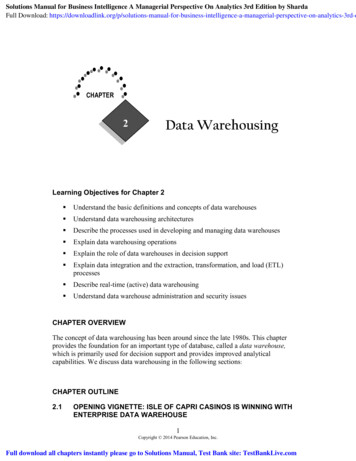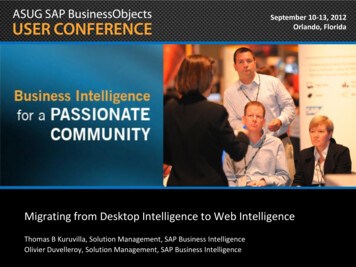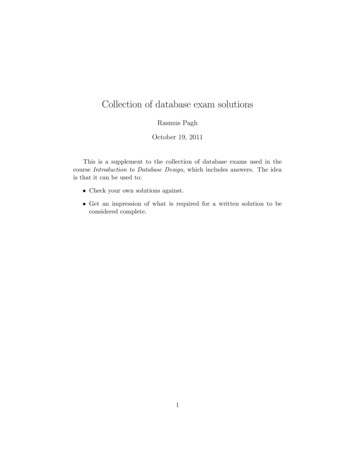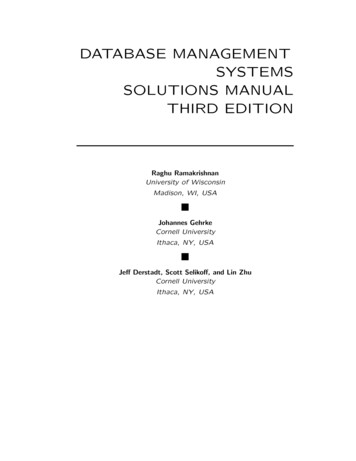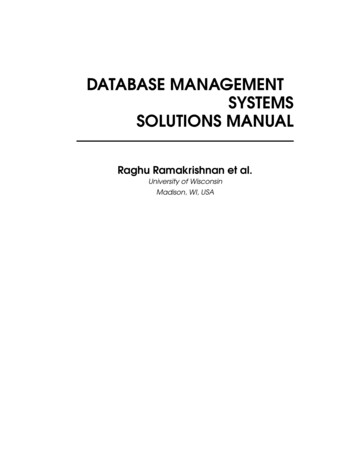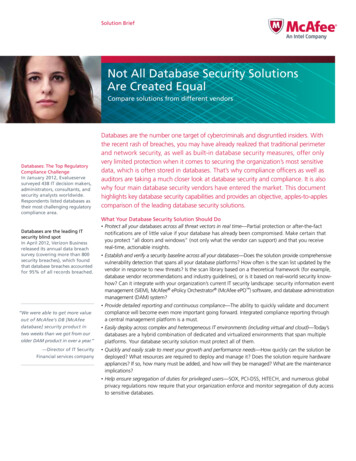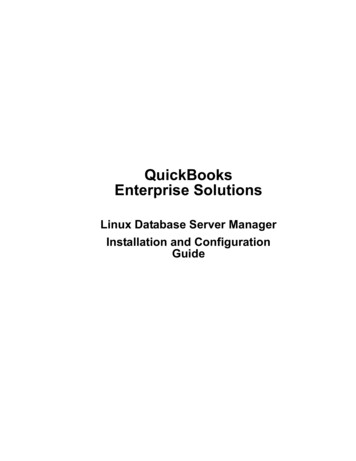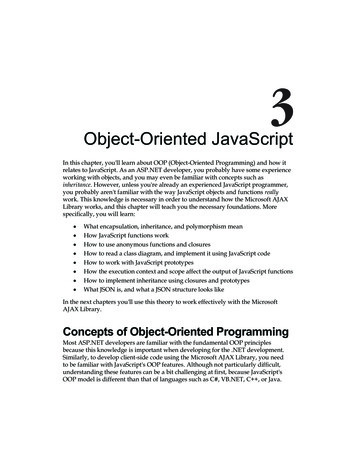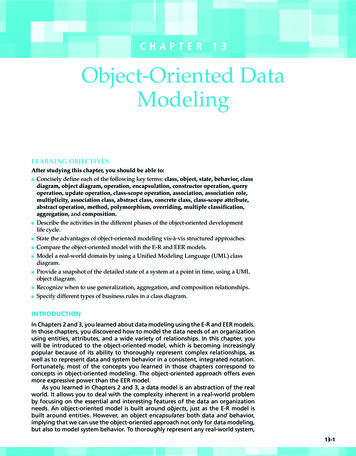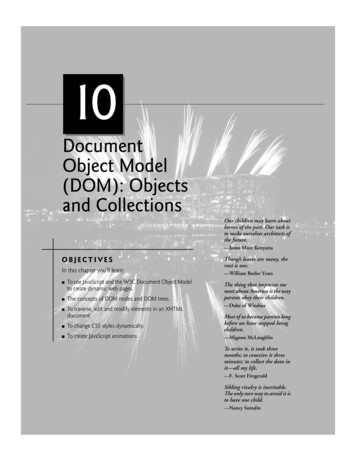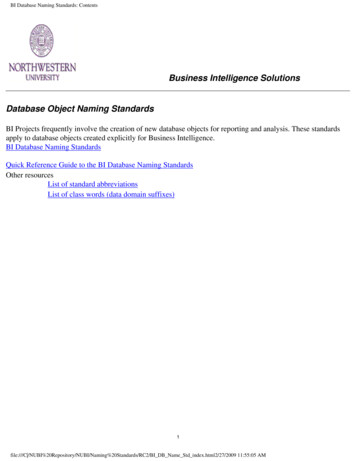
Transcription
BI Database Naming Standards: ContentsBusiness Intelligence SolutionsDatabase Object Naming StandardsBI Projects frequently involve the creation of new database objects for reporting and analysis. These standardsapply to database objects created explicitly for Business Intelligence.BI Database Naming StandardsQuick Reference Guide to the BI Database Naming StandardsOther resourcesList of standard abbreviationsList of class words (data domain suffixes)1file:///C /NUBI%20Repository/NUBI/Naming%20Standards/RC2/BI DB Name Std index.html2/27/2009 11:55:05 AM
BI Database Naming StandardsBusiness Intelligence SolutionsDatabase Object Naming StandardsContentsIntroductionScopePurposeDatabase object naming conventions for BI applicationsRelationship of BI names to source application system namesWhen the source application provides the basis for BI data names:When new names are created during BI designAdding database objects to BI applications not developed under this standardForming names for database objectsElements of a nameRules for forming namesNaming standards by object typeSchema namesTable namesView namesColumn namesIndex namesConstraint NamesHow to request additions and extensions to these standardsReferencesList of standard abbreviationsList of class words (data domain suffixes)Document HistoryIntroduction2file:///C /NUBI%20Repository/NUBI/Naming%20Standards/RC2/BI DB Name Std Main.htm (1 of 13)2/27/2009 11:55:07 AM
BI Database Naming StandardsScopeThese standards apply to database objects created and maintained for Business Intelligence applications.They apply to objects accessed during reporting and analysis, plus supporting objects such as those usedfor Extract, Transformation, and Load (ETL) processing.PurposeThese standards are intended to facilitate the design, implementation, and support of BI applications atNU. They are flexible and extensible. Suggestions for enhancements, and requests for extension toadditional object types or DBMS, are always welcome.A naming standard is a collection of rules, which, when applied to data, results in a set of data objectsnamed in a logical and standardized way. These names convey some information about the namedobjects; an element name, for example, indicates the set of possible valid values (its data domain), and itsusage.Having naming standards helps to achieve efficient use and reuse of data through better understanding ofwhat data is in the system. Standardized names enhance communications about data within the BIcommunity, from source application developers to BI experts to end users.Database object naming conventions for BI applicationsRelationship of BI names to source application system namesIn Business Intelligence applications, many data elements map to a column or field in an operationalapplication system that is the source of the BI data.Always consider using field and column names from the source application as the basis for creating thecolumn names in BI. This will usually speed ETL development and data modeling by supplying most ofthe object names ready-made, and facilitate communications between the BI team and the developerssupporting the source application.Guidelines for when to use (and not to use) source system field names as thebasis for BI namesThe guiding principle is that data names should aid in communication between interested and responsibleparties.Do use source application element names that are understood and used by its developers when discussingthe data.Also use source application element names that are closely related to the names used by developers and/or users, with minor technical differences like abbreviations and punctuation.When sourcing data from multiple applications, use source names when there is conformance, in bothnaming conventions and terminology, across the source applications.Source application element names that are in general use within the University should be used in BI.3file:///C /NUBI%20Repository/NUBI/Naming%20Standards/RC2/BI DB Name Std Main.htm (2 of 13)2/27/2009 11:55:07 AM
BI Database Naming StandardsExamples: NETID, CHARTSTRING.Do not use source application element names that do not describe the data in any meaningful way, such ascryptic names, and ones based on a language other than English.As a general rule: if developers and application users don’t use the application’s column and field nameswhen discussing its data content, using those names in the BI application would not be an aid tocommunications and so should be avoided.When the source application provides the basis for BI data names:The source application field and column names are the basis for the data element and column names inthe BI system, but they may be changed when creating the BI name, because:Some changes are for technical reasons. The main BI data store is an Oracle database in wheredata names are not case-sensitive, and “ ” (underscore) is the only word separator permitted.Example: source names “StudentLastName”, “student last name” and “STUDENT-LASTNAME” would all become “STUDENT LAST NAME” in the BI database.Names that are too short or that don’t convey enough meaning may be expanded, such as byadding a suffix, to clarify their usage.Example: source element “BUILDING” could become “BUILDING NUM”,“BUILDING ID”, or “BUILDING NAME” depending on the type of data it holds.For field and column names that are not related to data contents, choose a name in BI that bestfacilitates communication about the data element. Sometimes a new name should be assigned in BIthat describes the actual use of the element.Examples:1) An application has a column named “ORIGIN CODE” that is used to store data thatwould best be described as a “cost category code”, due to an application enhancementcompleted some years ago. Developers and expert users generally call it “origin code”. Inthis case, “ORIGIN CODE” would also be the name in BI.2) An application has a column named “MGR TITLE” that contains the manager emailaddress. Users and developers refer to it as “email” or “manager email”. A new name wouldbe assigned in BI, based on “manager” and “email”.Tables and other objects other than data elements are assigned new names in BI that draw on the sourceapplication’s terminology, but are not usually the same as the name of an object such as a file or table inthe source application.When new names are created during BI designWhen the source application element names don’t make a good basis for the BI names, due to multiple4file:///C /NUBI%20Repository/NUBI/Naming%20Standards/RC2/BI DB Name Std Main.htm (3 of 13)2/27/2009 11:55:07 AM
BI Database Naming Standardssource applications with incompatible naming, cryptic names, etc., then use this standard to create newnames for the BI data.When the source system names don’t describe data contents, then investigate other sources for the termsto be used in forming names. Look for user training materials, and discuss the labels and headings in theapplication’s user interface with both developers and users to identify good terms for the application’sdata items.Names in widespread use should be preserved, in the closest equivalent form allowed within technicalconstraints. Example: “NetID” (becomes “NETID” in BI).New names are formed as described in this standard.Adding database objects to BI applications not developed under this standardWhen adding database objects to a BI application that was not developed using this standard, their namesshould use the same naming conventions as used in the existing object names.This standard may be used together with the existing database objects names to develop new names,whenever that is helpful. The goals when extending the application data are consistency and thepromotion of communication among the interested parties, including the vendor or other developer of theBI application.This applies to purchased applications, and to others developed without using this standard.Forming names for database objectsElements of a nameData object names are formed from one or more prime words, optional qualifier words, and one classword.Prime words describe the major topic or subject area to which the data refers. Prime words should betaken from terminology commonly used in the University, including terms used in application systems.Every object name contains at least one prime word.Examples: student, campus, account, fund, project, building.Qualifier words describe the role of one particular data element within its subject area. They are optionalexcept when needed to create a set of unique names for similar data items (“project start date”, projectend date”, etc.).Examples: first, last, begin, end, type.Class words describe the type of data; they indicate the domain of potential values from which the dataitem’s valid values are drawn.Examples: name, number, amount, percent.5file:///C /NUBI%20Repository/NUBI/Naming%20Standards/RC2/BI DB Name Std Main.htm (4 of 13)2/27/2009 11:55:07 AM
BI Database Naming StandardsSources of the elements that form namesPrime and qualifier words should draw from the terminology in use by the developers and users of thesource applications when possible.This standard does not include an exclusive list of prime and qualifier words.The list of standard abbreviations (Standard Abbreviations) is a good source for prime andqualifier words, but if there is a word that more effectively communicates the description of a dataobject than any in the list, it can be used.Class words and their abbreviations must be taken from the standard list (Class Words (Data DomainSuffixes) ).Forming names from prime, qualifier, and class wordsMore than one prime word is used when needed to clearly define the data object and to create uniquenames when similar data items are stored together within a table or view.Examples: HOME COUNTRY NAME and RESIDENCE COUNTRY NAME;HR JOB TITLE, DEPARTMENT JOB TITLE, and SCHOOL JOB TITLE.Some data items belong to more than one data category, so the name should include multiple prime words.Example: a grade refers to the mark received by a student for a course. It describes neitherCOURSE nor STUDENT, but the relationship between STUDENT and COURSE. So columnswith grade-related data have names based on the two prime words STUDENT and COURSE.Class words may be omitted when they don’t add information. Some prime words convey the domain ofvalid values by themselves. But it’s never wrong toExamples:1) There are no commonly used codes for city names, so a column holding city names can benamed CITY NAME or CITY without raising questions about the possible values stored in thecolumn.2) The same is not true for states, so STATE must be followed by the class word NAME or CODE.Class words are not used in the names of objects such as tables and views.Class words are usually abbreviated, even when using the full word doesn’t exceed length restrictions.See abbreviations in the standard list (Class Words (Data Domain Suffixes) ).Rules for forming namesData object names are always singular. This includes the names of tables and views.6file:///C /NUBI%20Repository/NUBI/Naming%20Standards/RC2/BI DB Name Std Main.htm (5 of 13)2/27/2009 11:55:07 AM
BI Database Naming StandardsExamples: ROOM not ROOMS; ACCOUNT rather than ACCOUNTS; a table containing studentinformation has STUDENT in the name, not STUDENTS.Abbreviation rulesUse complete words for prime and qualifier words where possible, within restrictions on maximumlength.If spelling out the words in full causes the name to exceed the maximum allowed length,abbreviate starting with the longest word or words.For any long word (7 letters or more) that is used in multiple names, if it is abbreviated in anyname it should be abbreviated the same way wherever it occurs.The maximum length of names is 30 characters (as of 2008). Table and column names should be atmost 26 characters long, if that is possible without sacrificing the clarity of the name’s meaning, sothat related objects like constraints and indexes can contain the entire name.Standard abbreviations are listed here: Standard Abbreviations. For words not listed, if the sourceapplication has an abbreviation for the word, use it. You can also request a standard abbreviationfor words not in the list by contacting Business Intelligence Solutions.The “class word” or data domain suffix, which is the last element of the name when it is used, isusually abbreviated in names of any length. The abbreviations are listed here: Class Words (DataDomain Suffixes)Separate terms with an underscore (“ ”).Data element names should be concise; the full meaning depends on context. Do not repeat the tablename, or an abbreviation for it, in the names of its elements.Example: a column named COUNTRY NAME in a “Vendor Address” table doesn’t need to haveany reference to vendor or address in its name.Naming standards by object typeSchema namesSchemas generally correspond to the organization (school or department) that owns the source data, or isthe user of BI applications built for one specific organization.Exception: Key applications with users in many organizations may be placed in their own set of BIschemas rather than one based on the organization that is responsible for the data.Schema names start with a prefix that designates the type of data that the schema holds, followed by anidentifying name for the source application or the organization that owns the data.Standard prefixes for BI schema names: DM for DataMart, ETL for Data Manager Catalog, and STG for7file:///C /NUBI%20Repository/NUBI/Naming%20Standards/RC2/BI DB Name Std Main.htm (6 of 13)2/27/2009 11:55:07 AM
BI Database Naming Standardsdata staging.Schema name examples:1) BI data sourced from applications dedicated to the Office for Research Information Systems(ORIS) would have schemas DM ORIS to hold the Data Mart data (which could consist ofmultiple logical Data Marts or “stars”) and ETL ORIS for the ETL catalog.2) The College and University Financial System (CUFS) is an application with broad scope andhigh impact on the University’s administration. It is given its own set of BI schemas: ETL CUFS,STG CUFS, and DM CUFS.Table namesTable names are formed in the same way as the names of columns and views, using prime and qualifierwords.Tables that hold data in its final form, accessed by via reporting applications or used to manage the BIsystem, have no “class word” data domain suffix.Tables that are used for intermediate copies of data, used to capture and transform data and not accessedby user-facing applications, are in data class “work”, with names suffixed by class word “WRK”.The names of tables that implement a star schema have prefixes that specify the table’s role in the starschema model:“DIM” for dimension and“FACT” for fact.Tables that do not play a role in a dimensional star do not have any special prefix.Source application table and file names are not generally used in BI, though the BI name may be based ona source application table name. Tables that are used to capture application data prior to datatransformation, and have a one-to-one correspondence with a table or file in the source application,should have names that include or are based on the source application table.Table name examples:DIM PROTOCOL – Protocol dimension tableDIM ACCOUNT -- Financial account dimension tableFACT ACCOUNTING TRANS – Financial accounting transaction fact table (note: this is not a pluralname, TRANS is the abbreviation for TRANSACTION)ORGN WRK – Staging “work” table for initial capture of data from CUFS application table “ORGN”SECURITY ACCESS – table used to implement content-sensitive access controls within a Data Mart; itsrole is like a fact table in some queries (“what does user x have access to?”), and a dimension in others(“return facts a and b, filtered on dimensions x, y, z and security access”).View namesViews are named in the same way as tables. The view name is the same as the name that would be given8file:///C /NUBI%20Repository/NUBI/Naming%20Standards/RC2/BI DB Name Std Main.htm (7 of 13)2/27/2009 11:55:07 AM
BI Database Naming Standardsto a physical table containing the data presented by the view.Converting a view to a stored ordinary table or materialized view should be transparent to the applicationsthat read data via the view.View names must be unique within the set of all tables and views in a schema (this is a technicalrestriction; views and tables share a single name space in the database).A view used as a dimension or fact data source in reporting should have a prefix indicating the starschema role, just as with tables (DIM or FACT).Column namesNames based on field or column names in the source applicationFor these, there are three types of changes that may need to be made to the original name whenforming the equivalent BI name.1) Technical changes for conformance with the database syntaxNames are made up of letters and numbers and the underscore character (“ ”).Replace spaces by underscores, and special characters with a meaningful equivalent.Example: “room & board” becomes “ROOM AND BOARD”.Names have maximum length of 30 characters. Abbreviate long words to form validnames.The only word separator is the underscore character “ ”.Names are not case sensitive; by convention they are shown in all upper case indocumentation. Internal capitalization used to distinguish words will not bepreserved in the BI name. Underscores can be used to make the BI name moreunderstandable, except in cases where the source name is widely used.Examples: “FacultyLastName” becomes “FACULTY LAST NAME”;“NetID” becomes “NETID” (this name is in general use throughout theUniversity without an underscore).2) Changes to avoid conflicts with reserved words and keywords in the database andsupporting tools.Many words such as DATE, GRANT, GROUP, OPTION, RESOURCE, and SET arespecial to the database and cannot be used alone as column names. Tools used to manageand access the data often reserve words such as BEGIN, END, and CASE.Reserved words and special keywords are single words; the set of reserved words canchange with new software versions or the installation of new tools. A data domain suffixadded to single-word names avoids keyword conflicts with the current and future softwareversions.9file:///C /NUBI%20Repository/NUBI/Naming%20Standards/RC2/BI DB Name Std Main.htm (8 of 13)2/27/2009 11:55:07 AM
BI Database Naming StandardsExamples: If BEGIN and END hold dates they become BEGIN DT and END DT;to CLASS or GROUP add suffix “CD” (code), “NUM” (number), or“ID” (identifier), depending on the field’s contents.Note: Some single-word column names that do not conflict with database reserved wordsand are unlikely to do so in the future may be used unchanged in BI.Examples: CITY, COUNTY.3) Identifying columns, both those used as keys in the database and those used as importantidentifiers by end users, should have a data domain suffix added in BI if it is not present inthe original name. See “Keys and other identifiers”.Examples: SCHOOL becomes SCHOOL ID; AREA becomes AREA NUM.Naming columns in BI that don’t map directly to a source application data itemKeys: the ETL process usually adds new key identifiers (e.g. surrogate keys, concatenatedbusiness keys); these are named as described in the next section.Other columns should be named using the same style and terminology as existing sourceapplication field names where possible, else use the BI naming rules.Column names created for BIColumn names are formed according to the rules given in Forming names for database objects.Examples: STUDENT LAST NAME; EFFECTIVE END DT, ACCOUNT TYPE IDKeys and other identifiersIdentifying columns should be named with care as they are usually important to bothmanaging the data and reporting on it.There are several data domain suffixes (“class words”) that apply only to identifying dataitems:ID - An identifying field in the source application, especially when r
Data object names are formed from one or more prime words, optional qualifier words, and one class word. Prime words describe the major topic or subject area to which the data refers. Prime words should be taken from terminology commonly used in the

